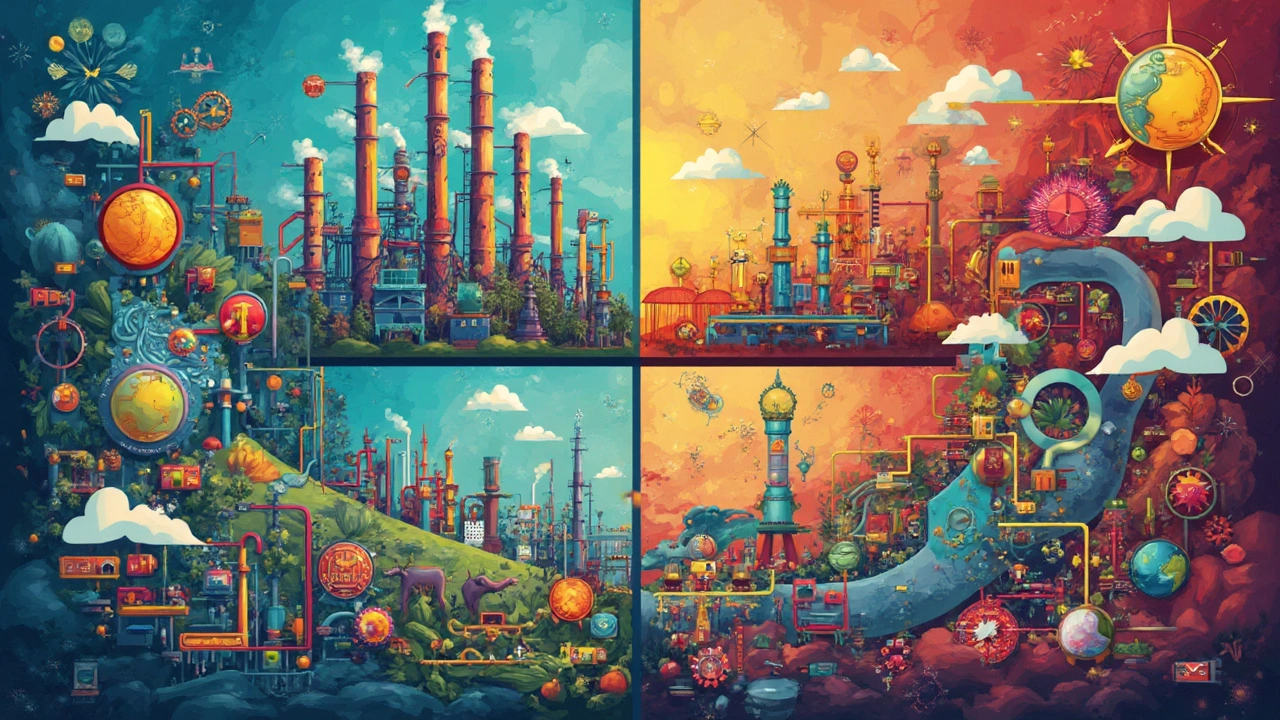The chemical industry in India is set for an exciting year in 2024, driven by emerging trends and new innovations. As a crucial part of the global supply chain, India's chemical sector plays a significant role in various industries, from agriculture to pharmaceuticals.
One big trend to watch is the shift towards sustainable practices. More companies are adopting environmentally friendly methods, not just because it's good PR, but because it actually reduces costs in the long run. Imagine cutting down on waste and energy use while still boosting production.
Another game-changer is digital transformation. New technologies like AI and IoT are revolutionizing how manufacturers operate, offering ways to optimize everything from supply chains to predictive maintenance. It's like giving the industry an upgrade to 'smart' status.
- Market Overview
- Key Trends to Watch
- Government Policies and Their Impact
- Challenges Faced by Manufacturers
- Future Opportunities and Strategies
Market Overview
In 2024, the chemical industry in India is looking pretty robust. It's not just me saying that—experts everywhere seem to agree. The industry's been clocking steady growth and evolving like nobody's business. Staying right there with some of the biggest global players, India's strides in this sector are noteworthy.
Here's why: India is the sixth-largest producer of chemicals globally and accounts for about 3% of the global chemical output. That's a solid place to be, but obviously, ambitions are much higher.
According to the Indian Brand Equity Foundation, "The Indian chemicals industry is projected to reach USD 304 billion by 2025." Now that's a number that really makes you think. There's a lot on the cards for the next few years, with 2024 being a critical stepping stone.
Strong Domestic Demand
The driving force behind this growth spurt is the domestic demand. With a population of over a billion folks, there’s always a need for more everything—be it fertilizers, polymers, or pharmaceuticals. The FMCG and automotive sectors alone significantly buoy the demand for chemicals.
Major Export Player
Besides looking inward, India is also turning heads on the international stage. The country's chemical exports have seen some promising upturns, helped along by competitive pricing and improving quality standards.
| Year | Chemical Exports Value (USD Billion) |
|---|---|
| 2022 | 23.5 |
| 2023 | 25.2 |
| 2024 (Projected) | 27.8 |
As the Indian chemical sector adapts to new trends like sustainability and digital transformation, it's not just about keeping pace—it's about leading the charge. With the right policies and strategies, the industry's expected to keep its upward trajectory robust.
Key Trends to Watch
The chemical industry outlook in India for 2024 is shaped by several key trends that are driving growth and innovation. Understanding these trends helps manufacturers stay competitive and adapt effectively to changes in the market landscape.
1. Sustainable Practices
Sustainability isn't just a buzzword anymore; it's becoming a necessity. Companies are increasingly under pressure to reduce their environmental footprint. This means cutting down emissions, using less water, and finding renewable energy sources.
"Our commitment to sustainability isn't just about compliance but about being leaders in creating a greener planet," said Ankit Mehta, CEO of EcoChem Industries.
By focusing on sustainable practices, manufacturers not only benefit the environment but also enhance their brand reputation, which can contribute to better sales and partnerships.
2. Digital Transformation
Another big trend is the move towards digitalization. The integration of technologies like artificial intelligence (AI) and the Internet of Things (IoT) is streamlining operations. This tech helps in reducing downtimes and maximizing output with data-driven strategies.
Imagine using sensors to predict machinery failures before they happen. That’s the power of digital transformation, giving companies an edge in efficiency and productivity. Plus, it can save significant costs annually, contributing to a more robust bottom line.
3. Government Policies and Incentives
The Indian government is actively promoting the chemical sector growth with policies and incentives. Tax benefits and subsidies for eco-friendly initiatives are encouraging companies to invest in greener technologies. Moreover, relaxed import-export norms are helping manufacturers access materials and markets more efficiently.
Such support is crucial as it enables local businesses to compete on a global scale, opening doors to international markets without the usual barriers.
4. Shift in Chemical Usage
With the rise of pharmaceuticals and specialty chemicals, the demand for chemicals used in these sectors is increasing. There's a significant focus on producing high-value chemicals like biochemicals and performance materials that have specific uses in healthcare and high-tech industries.
| Chemical Type | Demand Increase (%) |
|---|---|
| Pharmaceuticals | 15% |
| Specialty Chemicals | 18% |
| Biochemicals | 20% |
This shift represents huge opportunities for growth, encouraging manufacturers to diversify their product lines to meet this evolving demand.

Government Policies and Their Impact
India's government policies have always played a huge role in shaping the chemical industry outlook. For 2024, the government's focus is clear: boost innovation while ensuring sustainability. These policies aren't just on paper; they're turning into real actions that are affecting the market in significant ways.
One of the key moves has been the 'Production Linked Incentive' (PLI) scheme. This initiative aims to enhance domestic manufacturing and attract investors by offering financial incentives. It's like rolling out a red carpet for manufacturers, encouraging them to grow local production and reduce dependence on imports.
Another major aspect is the stricter regulations around pollution control and waste management. Sure, these are challenging for some manufacturers, but the long-term vision is to align with global environmental standards. This policy shift not only safeguards Mother Nature but also helps companies tap into new markets that prioritize sustainable products.
Boosting Investments and Innovation
The government isn't stopping at regulations. They're actively pushing for digital innovation by investing in research and development. Special funds have been allocated for tech advancements in the chemical industry, providing a fertile ground for startups and established firms alike to explore breakthroughs in materials and processes.
Moreover, tax benefits and subsidies for industries adopting green technologies are a welcome nod from the government. It's a win-win situation where the industry saves money while contributing to a cleaner environment.
Possible Challenges
However, these policies aren’t without their challenges. Not all companies can instantly adapt to new standards, especially small and medium enterprises. They often need support to upgrade facilities or integrate new tech, which is something the government will need to address effectively.
In summary, India's government is setting the stage for a more robust and globally competitive chemical sector through these policies. The outlook for 2024 looks promising, with the right mix of incentives and regulations paving the way for growth.
Challenges Faced by Manufacturers
The chemical industry in India, despite its promising outlook, doesn't escape its fair share of hurdles. Manufacturers have to navigate through a web of complexities to thrive in this dynamic sector.
Regulatory Compliance
Every manufacturer must adhere to stringent government regulations. Compliance can be a major headache, with rules changing more often than you'd like to think. These regulations, aimed at protecting the environment and ensuring safety, while necessary, can also slow down innovation if companies are constantly playing catch-up.
Supply Chain Disruptions
After the pandemic, any kinks in the supply chain can cause ripples throughout the industry. Manufacturers need reliable sources for raw materials, and disruptions can skyrocket costs and delay production. Think of it as a domino effect where one fall affects everything down the line.
Rising Costs
The cost of raw materials and transportation has been on the rise, squeezing margins for many chemical manufacturers. It's crucial for companies to find efficient ways to cut costs without compromising on quality. Some are turning to local sourcing to ease the pressure—it's about finding the right balance.
Technology Integration
While digital transformation offers benefits, integrating new tech isn't without its challenges. Manufacturers must upskill employees and overhaul existing processes, which can be both time-consuming and expensive. With the pace at which technology evolves, it's like racing in a marathon where the finish line keeps moving.
Manufacturers who can innovate while overcoming these obstacles will likely lead the industry, tapping into the immense growth potential that awaits in 2024 and beyond.

Future Opportunities and Strategies
Looking ahead, the chemical industry in India has several exciting opportunities on the horizon, thanks to technological advances and evolving market demands. To ride the wave toward growth, businesses need to adopt strategic approaches that tap into these emerging possibilities.
Embracing Digital Technologies
The march towards digitalization isn't slowing down. For chemical manufacturers, integrating AI and IoT can optimize operations like never before. Imagine predictive maintenance reducing unexpected downtimes or AI-based quality checks speeding up production without compromising standards. This tech-first approach could be a game-changer, cutting costs and increasing efficiency.
Focus on Green Chemistry
Sustainability isn't just a buzzword. It's rapidly becoming a necessity. By focusing on green chemistry, manufacturers can reduce their environmental footprint and appeal to a more eco-conscious consumer base. For instance, processes that minimize hazardous waste or use renewable resources can enhance both brand image and profit margins.
Leveraging Government Initiatives
The Indian government has been pushing policies that support the growth of the chemical sector. By staying informed about these initiatives, companies can align themselves better for competitive advantages. Whether it's tax incentives or R&D grants, the support can both fuel innovation and expand operational capabilities.
Strategic Global Partnerships
Alliances with international players can open doors to new technologies and markets. Indian companies benefit from global expertise, while foreign partners gain access to the expanding Indian market. It's a win-win that encourages knowledge exchange and fosters growth.
Investing in Skill Development
Lastly, a skilled workforce is the backbone of any industry. Investing in training and development ensures that employees are equipped to handle advanced technologies and processes. Consider collaborations with educational institutions to keep the talent pipeline fresh and competitive.
In a nutshell, India's chemical industry outlook for 2024 shines bright with possibilities. Being proactive and strategic can turn potential into real success.
